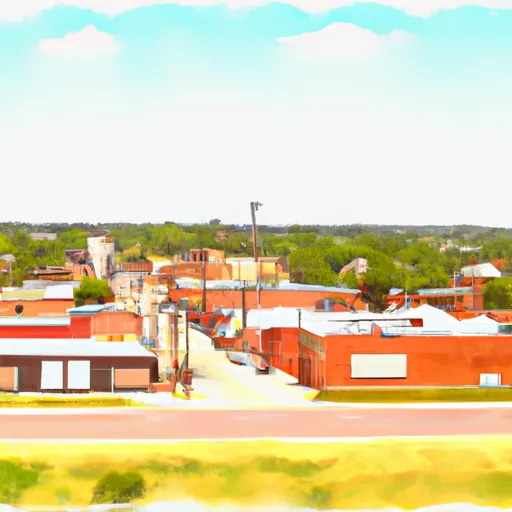-
 Snoflo Premium
Snoflo Premium
Get unlimited access to all our content
With no Ad interruptions! - Start Your Free Trial Login with existing account
Rubottom
Eden Index
Climate
9.8
•
Recreation
1.4
•
Community
1.8
•
Safeguard
4.8/10

Rubottom, Oklahoma is a small community located in Johnston County, with a population of around 100 residents. The climate in Rubottom is considered to be humid subtropical, characterized by hot summers and mild winters. Summers are typically long and hot, with temperatures often reaching into the 90s°F (32°C), while winters are relatively mild, with temperatures averaging in the 40s°F (4-9°C). Precipitation is spread evenly throughout the year, with an average annual rainfall of around 44 inches.
The hydrology constituents of Rubottom are mainly influenced by the Blue River, which flows nearby. The river provides a source of water for the community and supports a variety of aquatic life. Outdoor recreation opportunities in Rubottom are centered around the Blue River and its surrounding areas. Fishing enthusiasts can enjoy catching a variety of fish species, including bass, catfish, and crappie. The river also offers opportunities for boating, canoeing, and kayaking. Additionally, the scenic landscapes surrounding Rubottom provide opportunities for hiking, camping, and wildlife observation. Overall, Rubottom offers a peaceful and natural environment for outdoor enthusiasts to explore and enjoy.
What is the Eden Index?
The Snoflo Eden Index serves as a comprehensive rating system for regions, evaluating their desirability through a holistic assessment of climate health, outdoor recreation opportunities, and natural disaster risk, acknowledging the profound impact of these factors on livability and well-being.
Climate Health Indicator (CHI): 9.8
Rubottom receives approximately
923mm of rain per year,
with humidity levels near 77%
and air temperatures averaging around
17°C.
Rubottom has a plant hardyness factor of
7, meaning
plants and agriculture in this region tend to thrive during the non-winter months.
By considering the ideal temperature range, reliable water supplies, clean air, and stable seasonal rain or snowpacks, the Climate Health Indicator (CHI) underscores the significance of a healthy climate as the foundation for quality living.
A healthy climate is paramount for ensuring a high quality of life and livability in a region, fostering both physical well-being and environmental harmony. This can be characterized by ideal temperatures, reliable access to water supplies, clean air, and consistent seasonal rain or snowpacks.
Weather Forecast
Streamflow Conditions
Red-Lake Texoma
Area Rivers
Red-Lake Texoma
Snowpack Depths
Red-Lake Texoma
Reservoir Storage Capacity
Red-Lake Texoma
Groundwater Levels
Recreational Opportunity Index (ROI): 1.4
The Recreational Opportunity Index (ROI) recognizes the value of outdoor recreational options, such as parks, hiking trails, camping sites, and fishing spots, while acknowledging that climate plays a pivotal role in ensuring the comfort and consistency of these experiences.
Access to outdoor recreational opportunities, encompassing activities such as parks, hiking, camping, and fishing, is crucial for overall well-being, and the climate plays a pivotal role in enabling and enhancing these experiences, ensuring that individuals can engage in nature-based activities comfortably and consistently.
Camping Areas
| Campground | Campsites | Reservations | Toilets | Showers | Elevation |
|---|---|---|---|---|---|
| Healdton Municipal Lake | 57 | 900 ft | |||
| Tadra Point | 23 | 918 ft | |||
| Lake Thunderbird State Park - South | None | 1,146 ft | |||
| Arcadia Lake | 140 | 1,062 ft | |||
| Joe Benton Park - Lake Nocona | None | 852 ft | |||
| Mountain Lake | None | 1,002 ft | |||
| Black Creek Lake | 24 | 947 ft | |||
| Chandler City Park - Purcell | 25 | 1,091 ft | |||
| Tinker AFB Military | None | 1,253 ft | |||
| Lake Thunderbird State Park - North | None | 1,081 ft |
Nearby Ski Areas
Catastrophe Safeguard Index (CSI):
The Catastrophe Safeguard Index (CSI) recognizes that natural disaster risk, encompassing floods, fires, hurricanes, and tornadoes, can drastically affect safety and the overall appeal of an area.
The level of natural disaster risk in a region significantly affects safety and the overall livability, with climate change amplifying these risks by potentially increasing the frequency and intensity of events like floods, fires, hurricanes, and tornadoes, thereby posing substantial challenges to community resilience and well-being.
Community Resilience Indicator (CRI): 1.8
The Community Resilience Indicator (CRI) recognizes that education, healthcare, and socioeconomics are crucial to the well-being of a region. The CRI acknowledges the profound impact of these elements on residents' overall quality of life. By evaluating educational resources, healthcare accessibility, and economic inclusivity, the index captures the essential aspects that contribute to a thriving community, fostering resident satisfaction, equity, and social cohesion.

